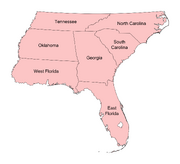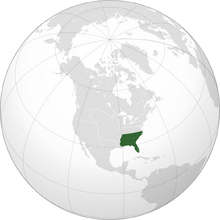Audemus jura nostra defendere (Latin) ("We Dare To Defend Our Rights") | |||||||
| Capital | Charleston | ||||||
| Largest city | Jacksonville | ||||||
| Other cities | Atlanta, Memphis, Mobile | ||||||
| Language official |
English | ||||||
| others | Cherokee, Spanish | ||||||
| Religion main |
Baptism | ||||||
| others | Catholicism, Judaism | ||||||
| Demonym | Carolinian | ||||||
| Government | Presidential federal republic | ||||||
| Legislature | Congress | ||||||
| President | Mike Huckabee (D) | ||||||
| Area | 930,164 km² | ||||||
| Population | 43,500,900 | ||||||
| Established | February 4, 1791 | ||||||
| Currency | Dollar (CLD)
| ||||||
| Internet TLD | .cl | ||||||
The Carolinian Confederacy, colloquially known as Carolina, is a sovereign state located along the Atlantic and Gulf coasts of southern North America. The nation borders Virginia to the north, Louisiana to the west, and maritime borders with the Bahamas and Cuba to the southeast.
The area of pre-Columbian Carolina was dominated by the native peoples who become known as the Five Civilized Tribes. The French, English, and Spanish would collectively dominate the area throughout the 17th and 18th centuries. By the 1760s, the British had establish the colonies of East Florida, Georgia, North Carolina, South Carolina, and West Florida; leaving the interior for the native peoples. These colonies (with the exception of the Floridas) would support the ideals of the American Revolution, with South Carolina becoming the first colony to declare independence in March 1776. These three colonies would become part of the United States of America by 1778, while the Floridas were retaken by the Spanish.
Following the dissolution of the United States of America in 1788, the colonies of Georgia, North Carolina, and South Carolina would continue to cooperate with each other. This alliance would be formalized on February 7, 1791, with the formation of the Carolinian Confederacy. The new nation adopted a constitution which allowed for a six-year presidency and a bicameral Congress proportioned based on population, with the city of Charleston would become the national capital. The three founding states would also relinquish their westernmost territories to the federal government to be admitted as new states in the future. South Carolinian Charles Cotesworth Pinckney would be elected as the nation's first President.
Carolina would play a significant role in the proclaimed Republic of West Florida and would eventually admit the state in 1815, with the Spanish selling East Florida in 1819. A key figure for the independence of the Floridas was General Andrew Jackson, who would be elected president in the late 1820s. Jackson's administration would be noted for his appeal to the common man and the forced relocating of the native peoples to modern day Oklahoma (the Trail of Tears).
The economy of Carolina would grow throughout the early 19th century as the nation dominated in the production and exportation of cotton and other cash crops. This was also successful due to the continued use of slave labor within the nation and the abundance of useful farmlands across the nation. By the later 1800s, Carolina's agricultural dominance would begin to decline as the British and northern American Republics began to invest in other means of cotton production (more notably in British India and post-slavery Virginia). Despite continued international pressure to abolish slavery and a declining economy, Carolina would not nationally abolish slavery until the late 1910s as the boll weevil would virtually the production of cotton impossible within the nation. Despite the end of slavery, a system of racial segregation would continue to dominate Carolina.
The early 1900s would see the rise of populism across the nation and became supported by former slaves and poor whites. Populist president Huey Long would approve measures to improve the economy and standard of living for all Carolinians.
Government and Politics[]
Political Parties[]
- Major Parties
- Democratic Party — conservatism, Christian democracy
- People's Party — liberalism, populism, third way
Subdivisions[]

States of Carolina.
The Carolinian Confederacy is a federation comprised of seven states and a capital district.
- States
Georgia (Atlanta)
East Florida (St. Augustine)
North Carolina (Raleigh)
Oklahoma (Columbus)
South Carolina (Columbia)
Tennessee (Nashville)
West Florida (Pensacola)
- Capital District
| ||||||||||
| |||||
![]() This 13 Fallen Stars related article is a stub. Please add suggestions on the talk page.
This 13 Fallen Stars related article is a stub. Please add suggestions on the talk page.




